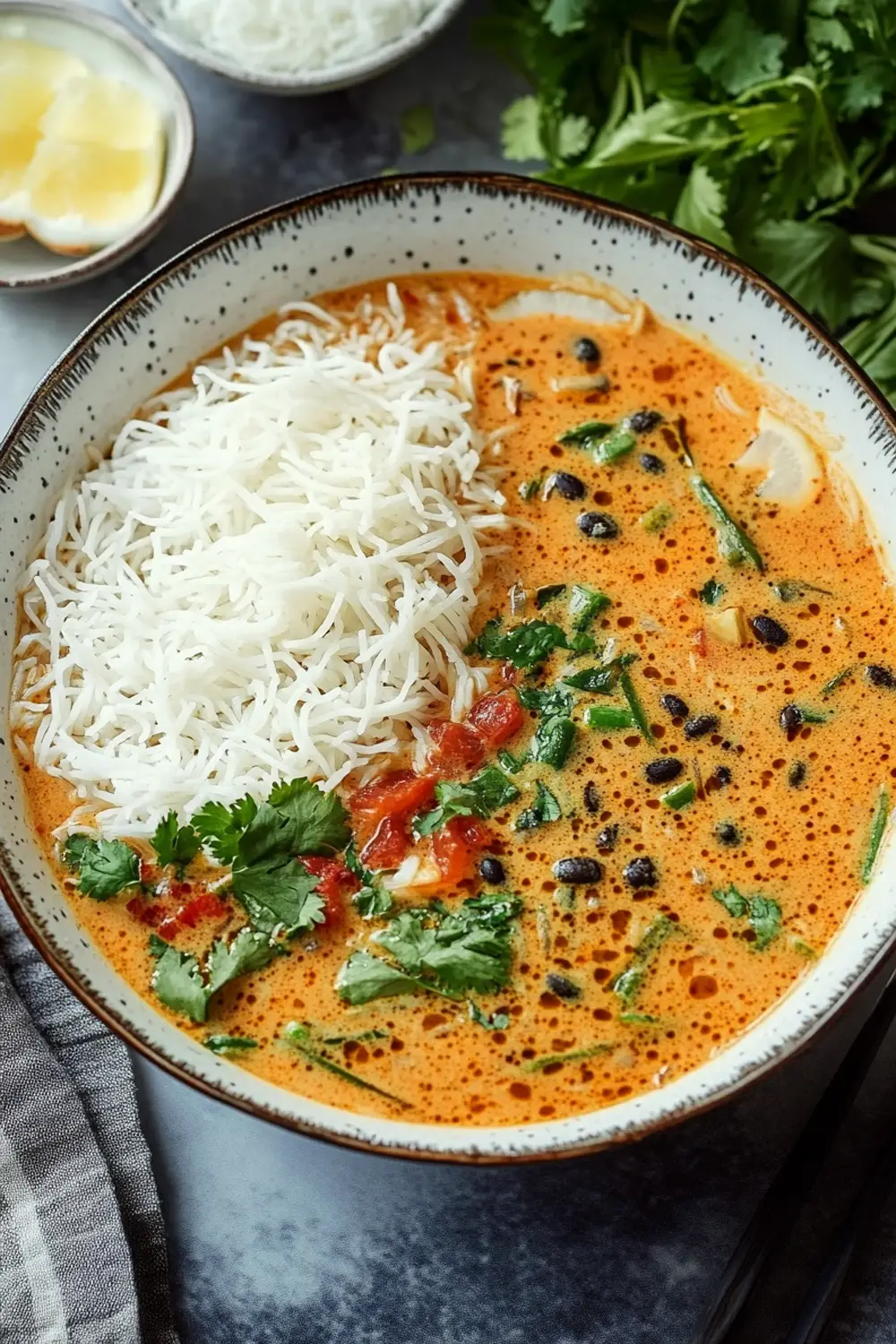Why Spicy Thai Coconut Soup Feels Like a Warm Hug
he first time I tried Spicy Thai Coconut Soup—Tom Kha Gai—I was on a bustling street in Bangkok, with the aroma of lemongrass and chili wafting through the air. One spoonful of its creamy, tangy broth, and I was hooked. The delicate balance of flavors—spicy, sour, salty, and sweet—is like a symphony for the taste buds.
Now, whenever I make this soup at home, it feels like a mini getaway to Thailand, right in my kitchen. This recipe brings together the authentic essence of Thai cuisine with an approachable, homemade twist, offering layers of flavor that are bold, vibrant, and utterly unforgettable.
Good food transports you—it turns an ordinary evening into an adventure.
Key Takeaways
- Complex Flavors, Simple Steps: Despite its layered taste, this soup is straightforward to make.
- Customizable: Adjust the spice level, add your favorite protein, or even make it vegan.
- Perfect for All Seasons: Whether it’s a chilly evening or a summer night, this soup always hits the spot.
- Nutritious and Wholesome: Packed with fresh herbs, creamy coconut milk, and healthy vegetables.

Spicy Thai Coconut Soup is a reminder that cooking can be an act of exploration and discovery
Ingredients: A Symphony of Thai Flavors
This recipe makes 4 hearty servings, perfect for sharing or saving leftovers.
For the Broth:
- 1 tbsp vegetable oil
- 1 medium onion (sliced)
- 3 cloves garlic (minced)
- 1 tbsp fresh ginger (grated)
- 2 stalks lemongrass (smashed and chopped into 2-inch pieces)
- 4 cups chicken broth (or vegetable broth for a vegan version)
- 2 cups coconut milk (full-fat for creaminess)
- 1 tbsp red curry paste
- 2 tbsp fish sauce (or soy sauce for vegan)
- 1 tbsp brown sugar
- Juice of 2 limes
For the Add-Ins:
- 1 lb boneless chicken thighs (thinly sliced; or tofu for vegan)
- 1 cup mushrooms (shiitake or button, sliced)
- 1 red bell pepper (sliced)
- 1 cup snap peas or green beans
- 1–2 red chilies (sliced; adjust for spice preference)
- 1/2 cup cherry tomatoes (halved)
- Fresh cilantro and Thai basil (for garnish)
- Lime wedges (for serving)
Equipment Needed
- Large pot or Dutch oven
- Wooden spoon for stirring
- Ladle for serving
- Fine mesh strainer (optional, for removing lemongrass and ginger)
Each ingredient plays its part to create a dish that’s vibrant, aromatic, and deeply satisfying.

Step-by-Step Guide to Spicy Thai Coconut Soup
Making Spicy Thai Coconut Soup is like creating a symphony of flavors in your kitchen. Each step brings another layer of richness, spice, and aroma, transforming simple ingredients into an extraordinary bowl of comfort. Follow these easy steps to bring the taste of Thailand to your table.
Step 1: Sauté the Aromatics
Heat vegetable oil in a large pot over medium heat. Add the onion, garlic, and ginger. Sauté for 2–3 minutes until fragrant and slightly softened.
Tip: Don’t rush this step. The aromatics are the flavor foundation of the soup—cook them gently to avoid burning.
Step 2: Build the Broth
Add the lemongrass, chicken broth, coconut milk, red curry paste, fish sauce, and brown sugar. Stir well to combine. Bring the mixture to a gentle simmer and let it cook for 10 minutes, allowing the flavors to meld beautifully.
Tip: Smash the lemongrass with the back of a knife before adding it to release its citrusy aroma more effectively.
Step 3: Add the Chicken and Vegetables
Stir in the sliced chicken thighs, mushrooms, bell pepper, snap peas, and cherry tomatoes. Simmer for another 10–12 minutes, or until the chicken is cooked through and the vegetables are tender but still vibrant.
Tip: Slice the chicken thinly and evenly so it cooks quickly and absorbs the flavorful broth.
Step 4: Finish with Lime and Spice
Remove the pot from heat. Stir in the lime juice and taste the soup, adjusting the seasoning with more fish sauce, lime juice, or sugar if needed. Add the sliced red chilies for heat, if desired.
Tip: Taste as you go and aim for balance—spicy, sour, salty, and sweet should all be present without one overpowering the others.
Step 5: Serve and Garnish
Ladle the soup into bowls and garnish with fresh cilantro and Thai basil. Serve with lime wedges on the side for an extra zing.
Tip: Add garnishes just before serving to maintain their freshness and vibrant color.
Step 6: Serve and Enjoy
Ramen isn’t just about eating—it’s about the experience. Serve immediately while the broth is piping hot, and encourage everyone to slurp their noodles. Not only is it tradition, but it’s also the best way to fully enjoy the flavors.
Ramen is a meal best enjoyed with gusto—don’t be shy about making some noise!
Every bowl is a celebration of flavor and color—perfect for savoring or sharing.

More Tips for Perfect Thai Coconut Soup
- Don’t Skip the Lemongrass: It’s the heart of this dish, providing a fresh citrusy aroma that ties everything together.
- Full-Fat Coconut Milk: For a rich, creamy texture, always use full-fat coconut milk.
- Balance the Flavors: Thai cuisine is all about balance—taste as you go to ensure the soup hits the perfect spicy, sour, salty, and sweet notes.
- Make It Vegan: Swap chicken for tofu and fish sauce for soy sauce or coconut aminos.
- Serve Immediately: This soup is best enjoyed fresh, while the vegetables retain their vibrant color and crisp texture.
Serving Suggestions: A Thai-Inspired Feast
Pair with Jasmine Rice
Serve alongside steamed jasmine rice to soak up the creamy broth.
Add Crunch
Include a side of crispy spring rolls or prawn crackers for a delightful textural contrast.
Thai Iced Tea
Complement the spice with a refreshing glass of Thai iced tea or a cold Singha beer.
Family-Style Meal
Turn this soup into the star of a Thai-inspired dinner spread with dishes like pad thai, green curry, or papaya salad.
Every spoonful of soup is a mini trip to Thailand—why not make it a full journey with a few sides?

Creative Variations: Make Spicy Thai Coconut Soup Your Own
Thai cuisine is all about balance and adaptability, making this soup a perfect canvas for customization. Whether you’re catering to dietary needs or simply exploring new flavors, here are some inspired ways to make this recipe truly your own:
Seafood Twist
Transform this soup into a seafood delight by swapping chicken for shrimp, scallops, or chunks of white fish. Add them in the last 5 minutes of cooking to prevent overcooking.
Pro Tip: A splash of fish sauce alongside the seafood enhances the oceanic flavors beautifully.
Spicy and Tangy
Turn up the heat with additional Thai bird’s eye chilies or a spoonful of chili oil. For an extra tangy kick, increase the lime juice or add a touch of tamarind paste to the broth.
Tip: Garnish with a few chili flakes for a bold presentation and extra spice!
Vegan Option
Replace chicken with cubes of firm tofu or tempeh and use vegetable stock instead of chicken broth. The coconut milk keeps it creamy, and fresh mushrooms add an umami boost.
Tip: Add extra vegetables like zucchini or kale to make the dish heartier while staying plant-based.
Coconut-Free Alternative
For those avoiding coconut, substitute cashew cream or oat cream to maintain the creamy texture. While it changes the flavor profile slightly, it still results in a rich and satisfying soup.
Pro Tip: Adding a bit of peanut butter can mimic the nutty undertones of coconut milk.
Noodle Enrichment
Turn this soup into a complete one-bowl meal by adding rice noodles, udon noodles, or even spiralized zucchini for a low-carb option.
Tip: Cook the noodles separately and add them to each bowl before serving to prevent them from soaking up too much broth.
Seasonal Vegetables
Make the soup reflect the season by adding vegetables like roasted sweet potatoes in winter or fresh green beans and snap peas in summer.
Tip: Roasting your vegetables before adding them elevates their flavor and texture.
The beauty of Thai cooking lies in its adaptability—don’t be afraid to get creative and make this dish uniquely yours.

Storage and Reheating: Keep It Fresh and Delicious
Storage
- Refrigerator: Allow the soup to cool completely before transferring it to an airtight container. Store in the refrigerator for up to 3–4 days.
- Freezer: To freeze, omit the vegetables (they can become mushy) and store the broth with protein in a freezer-safe container for up to 3 months. Add fresh vegetables when reheating for the best texture.
Reheating
- Stovetop: Pour the soup into a pot and reheat over medium heat until warmed through. If frozen, thaw in the refrigerator overnight before reheating.
- Microwave: Heat individual portions in a microwave-safe bowl in 30-second intervals, stirring in between, until heated evenly.
- From Frozen: Reheat gently on the stovetop, adding freshly cooked vegetables or noodles as needed.
Tip: To maintain the soup’s fresh and vibrant flavor, always garnish with fresh herbs and a squeeze of lime after reheating.
Common Mistakes to Avoid
Even with a simple recipe like Spicy Thai Coconut Soup, a few missteps can impact the final result. Here’s how to steer clear of the most common pitfalls:
Overcooking the Vegetables
Thai cuisine is celebrated for its vibrant and fresh ingredients. Overcooking the vegetables can lead to a mushy texture and dull appearance. Add them toward the end of cooking to maintain their crispness and bright color.
Tip: Blanch harder vegetables like snap peas or green beans before adding them to the soup for a perfect texture.
Skipping the Lemongrass
Lemongrass is a star ingredient in this dish, providing its signature citrusy aroma. If fresh lemongrass isn’t available, use lemongrass paste or lemon zest as a substitute, but don’t skip it entirely.
Tip: Smash the lemongrass stalks with the back of a knife to release their oils for maximum flavor.
Using Low-Fat Coconut Milk
While low-fat coconut milk is an option, it lacks the creamy richness that gives this soup its indulgent texture. Always choose full-fat coconut milk for the best results.
Tip: Shake the can well before opening to ensure the cream and liquid are properly mixed.
Adding Lime Juice Too Early
Lime juice is crucial for the soup’s tangy finish, but adding it while the soup is still simmering can mute its vibrant flavor. Always stir it in at the end, just before serving.
Tip: Serve with extra lime wedges for guests to adjust the tanginess to their liking.
Overloading on Spice
While Thai cuisine is known for its bold flavors, too much spice can overwhelm the delicate balance of the soup. Start with a small amount of chili and adjust gradually to suit your taste.
Tip: If the soup becomes too spicy, balance it out with a little extra coconut milk or sugar.
Cooking is an art, but all art requires knowing which mistakes to avoid.

Conclusion
Spicy Thai Coconut Soup is a sensory experience. From the bold aroma of lemongrass and ginger to the creamy richness of coconut milk, each spoonful is a journey to the heart of Thai cuisine. Whether you’re cooking for family, hosting friends, or simply treating yourself, this soup offers a perfect balance of flavors that feels both indulgent and nourishing.
Let it remind you of the joy in exploring new tastes and creating something meaningful in your kitchen. Serve it with love, savor it slowly, and let the warmth and vibrancy of this recipe bring a little adventure to your day.
FAQ
Can I freeze this soup?
Yes! Freeze the soup without the vegetables for best results. Add fresh vegetables when reheating.
How can I make it less spicy?
Reduce the amount of red curry paste and skip the fresh chilies.
What if I can’t find lemongrass?
Substitute with a teaspoon of lemon zest and a few drops of lemon juice.
Can I use light coconut milk?
You can, but the soup will be less creamy and rich.
What protein works best for this soup?
Chicken, shrimp, tofu, or even thinly sliced beef are all great options.
Can I use dried herbs instead of fresh?
Yes, but fresh herbs like Thai basil and cilantro provide the best flavor.
What makes this soup tangy?
Lime juice adds the tangy, citrusy note that balances the creamy broth.
How do I thicken the soup?
You can simmer it longer to reduce the broth slightly or add a cornstarch slurry.
What’s the best substitute for fish sauce?
Soy sauce, tamari, or coconut aminos work well.
Can I make this soup in advance?
Absolutely! The flavors develop beautifully overnight. Just add fresh vegetables before reheating.


Spicy Thai Coconut Soup
Equipment
- Large pot or Dutch oven
- Wooden spoon
- Ladle
- Fine mesh strainer (optional, for removing lemongrass)
Ingredients
For the Broth:
- 1 tbsp vegetable oil
- 1 medium onion sliced
- 3 cloves garlic minced
- 1 tbsp fresh ginger grated
- 2 stalks lemongrass smashed and chopped into 2-inch pieces
- 4 cups chicken broth or vegetable broth for a vegan version
- 2 cups coconut milk full-fat
- 1 tbsp red curry paste
- 2 tbsp fish sauce or soy sauce for vegan
- 1 tbsp brown sugar
- Juice of 2 limes
For the Add-Ins:
- 1 lb boneless chicken thighs thinly sliced; or tofu for vegan
- 1 cup mushrooms shiitake or button, sliced
- 1 red bell pepper sliced
- 1 cup snap peas or green beans
- 1 –2 red chilies sliced; adjust for spice preference
- 1/2 cup cherry tomatoes halved
- Fresh cilantro and Thai basil for garnish
- Lime wedges for serving
Instructions
- Sauté the Aromatics:
- Heat the vegetable oil in a large pot over medium heat. Add the onion, garlic, and ginger. Sauté for 2–3 minutes until fragrant.
- Build the Broth:
- Add the lemongrass, chicken broth, coconut milk, red curry paste, fish sauce, and brown sugar. Stir well to combine. Simmer for 10 minutes to allow the flavors to meld.
- Add the Chicken and Vegetables:
- Stir in the sliced chicken thighs, mushrooms, bell pepper, snap peas, and cherry tomatoes. Simmer for another 10–12 minutes until the chicken is cooked through and the vegetables are tender.
- Finish with Lime and Spice:
- Remove the pot from heat. Stir in the lime juice and adjust the seasoning with more fish sauce, lime juice, or sugar, if needed. Add sliced chilies for extra heat.
- Serve and Garnish:
- Ladle the soup into bowls and garnish with fresh cilantro, Thai basil, and lime wedges.
Notes
Adjust the spice level to your preference by using fewer or more chilies.
- IT’S TIME TO HIT PAUSE AND EAT: This is more than a bowl. Mora is Latin for “Pause”, acting as a reminder to slow down i…
- LEAD FREE ALL NATURAL GLAZE: We know that lead is a poison, but what some of us don’t know is that it is in a lot of cer…
- CRYSTALLIZED SCRATCH RESISTANT FORMULA: Our glaze is not only lead free, but also extra strong to prevent scratches from…
This post contains affiliate links. If you purchase through these links, we may earn a small commission at no extra cost to you. As an Amazon Associate, we earn from qualifying purchases. Thank you for your support!









Jill Hower
03/27/2025I’d like to make this soup but I’d like 2 substitute lemongrass paste. How much do you think I should use?
Sandra&Martin
03/27/2025Hi Jill!
Great question—and yes, you can absolutely use lemongrass paste instead of fresh.
Since the paste is more concentrated (and there are so many different kinds out there), we recommend starting with 1 flat teaspoon for this soup, which makes about 6 to 7 cups (4 hearty servings).
From there, taste after simmering and add more if you’d like a brighter lemongrass note—you can go up to 2 flat teaspoons – depending on how bold you want the flavor.
Everyone’s taste is different, so go with what feels right for you
—and we’d love to hear how it turns out and how much paste ended up being just right for you!
Happy cooking! 😊